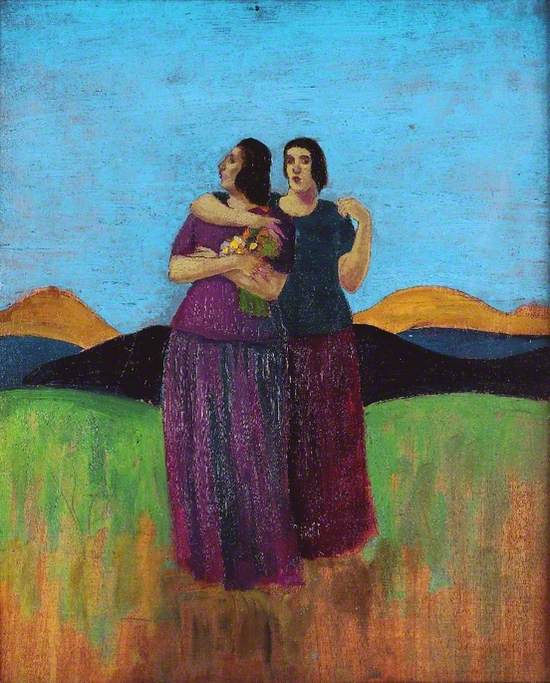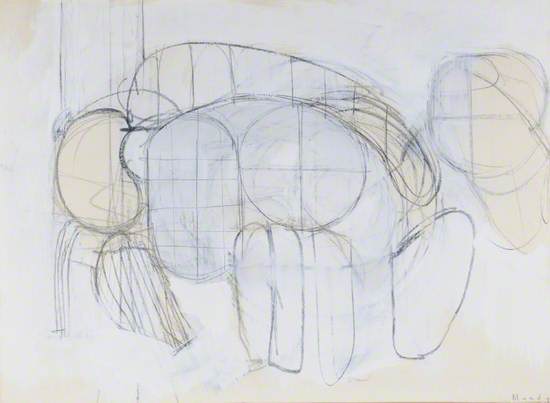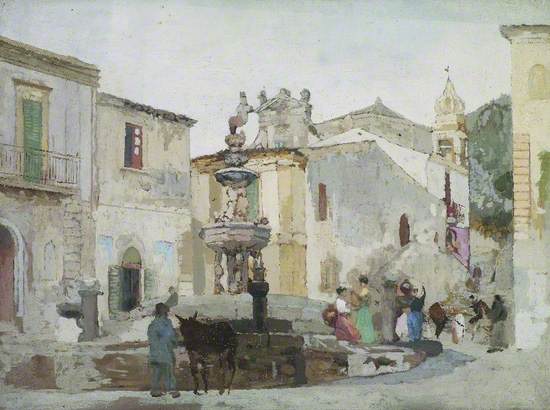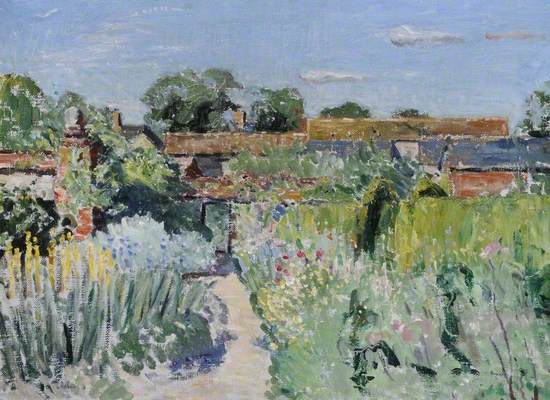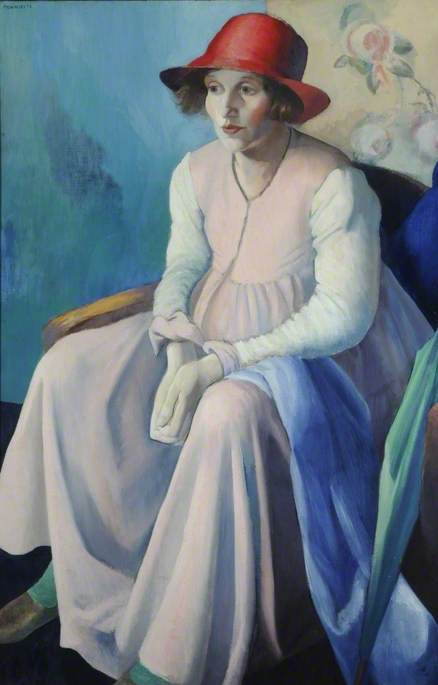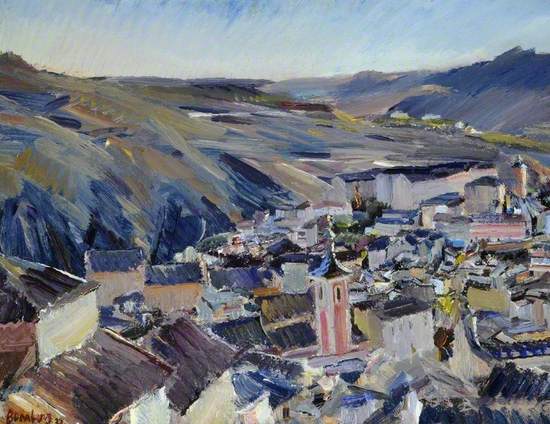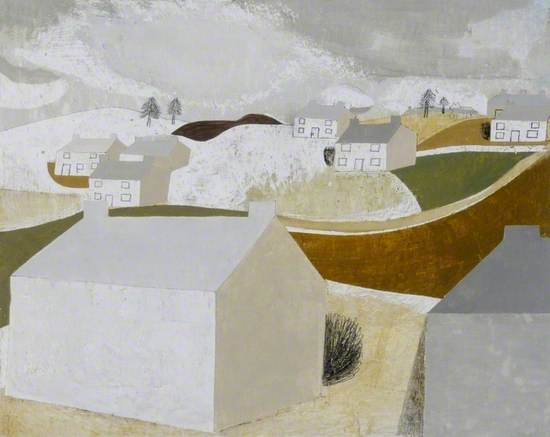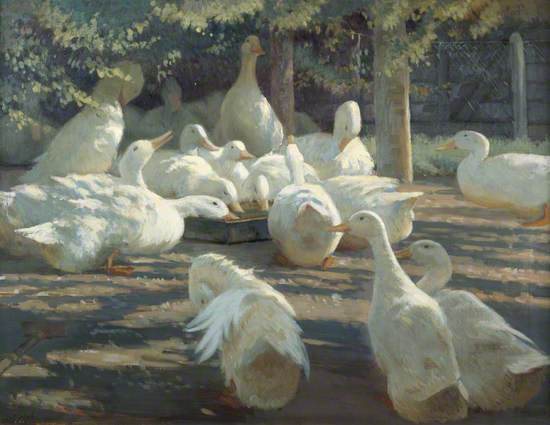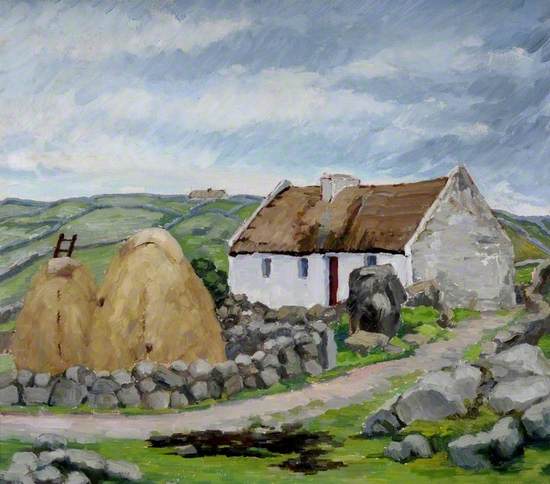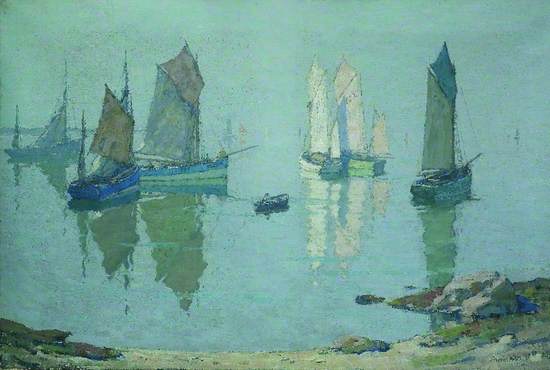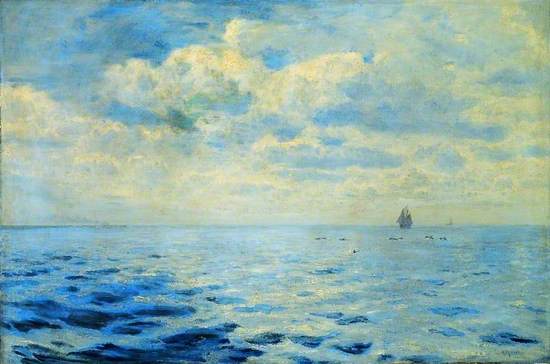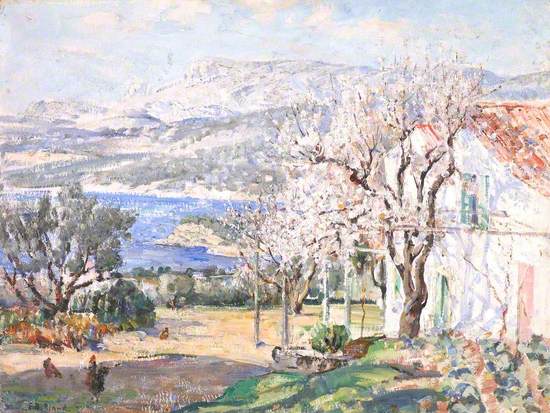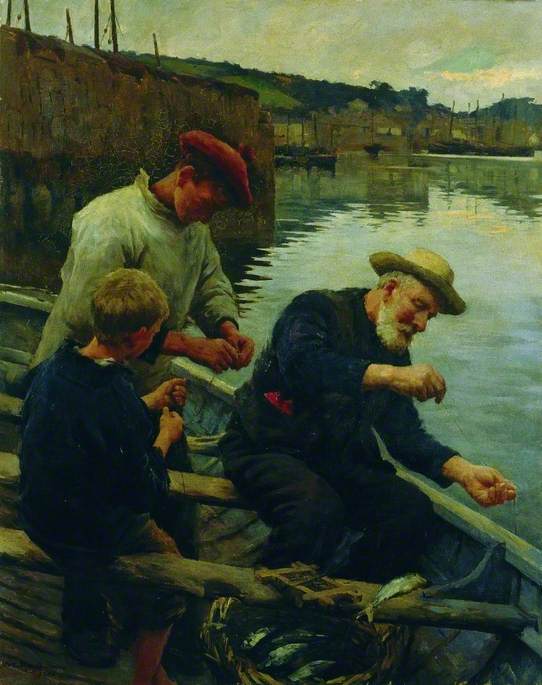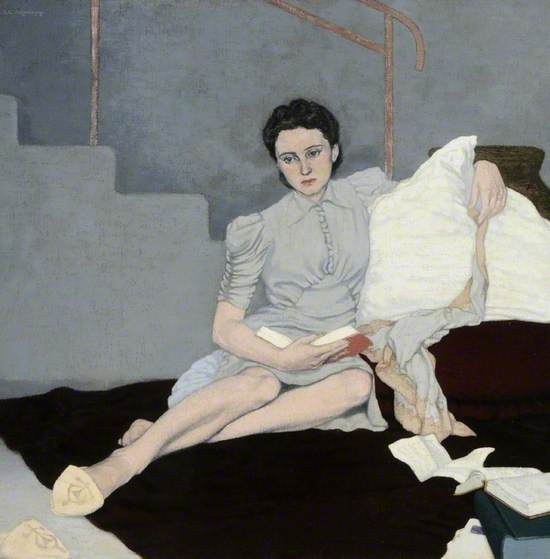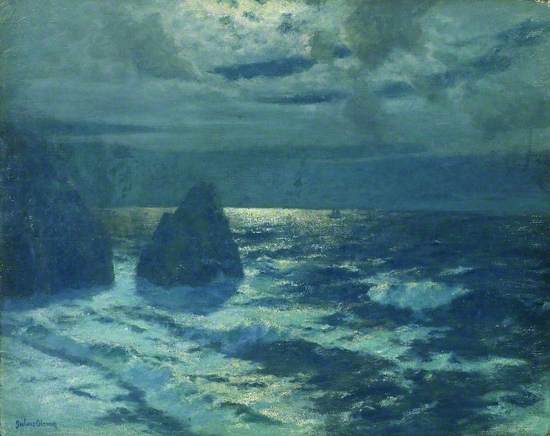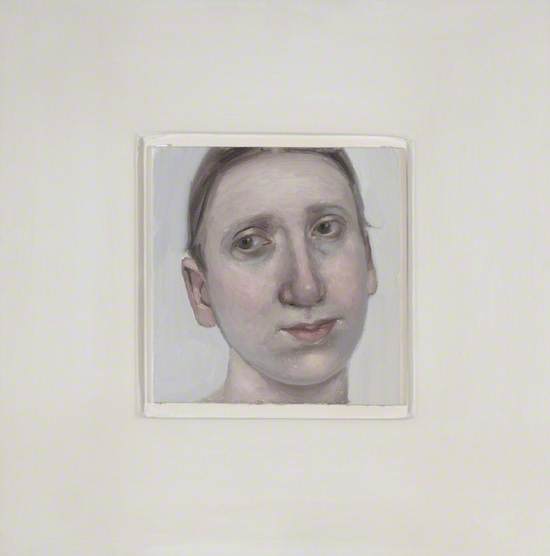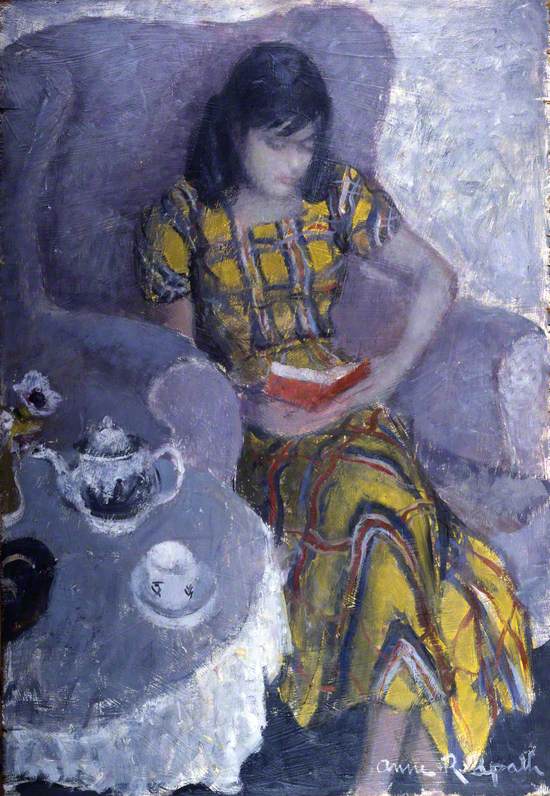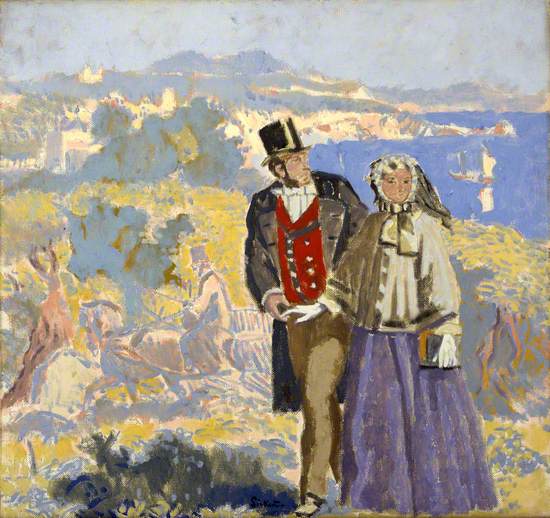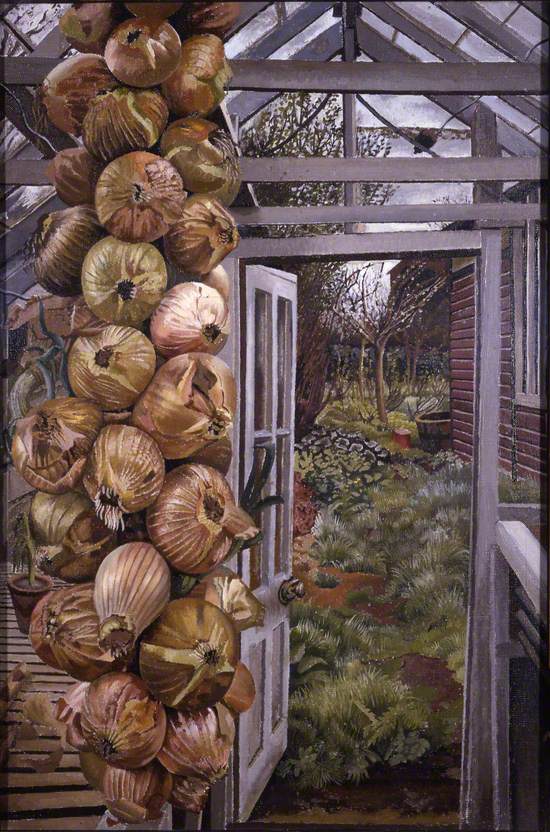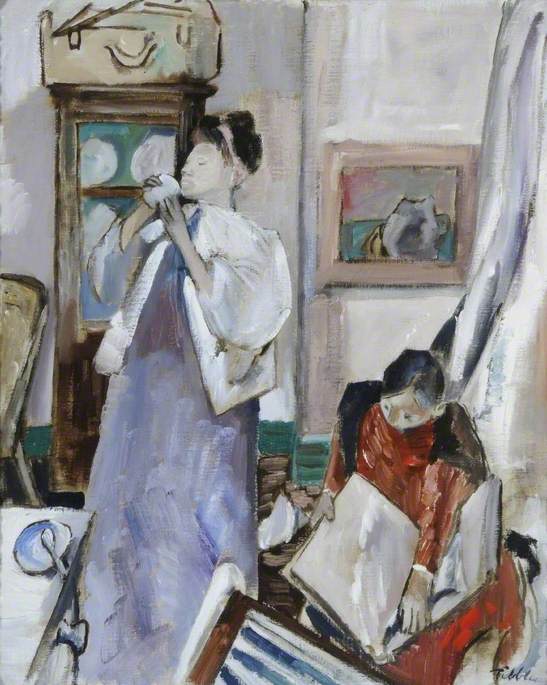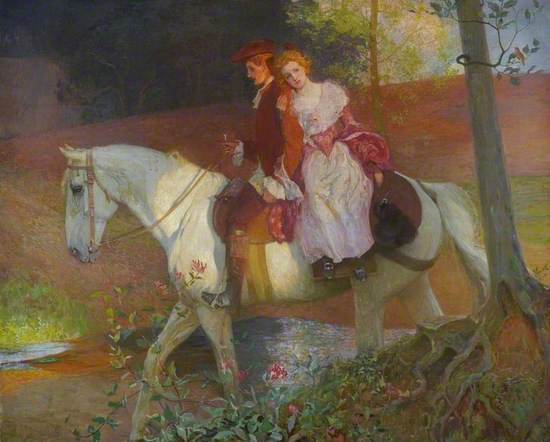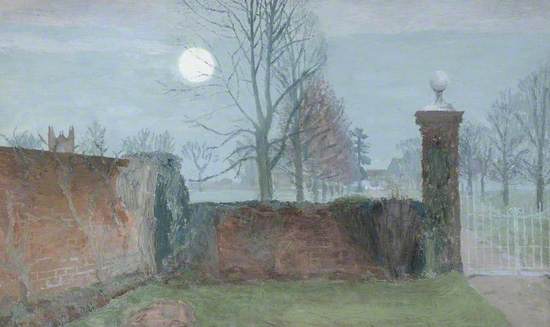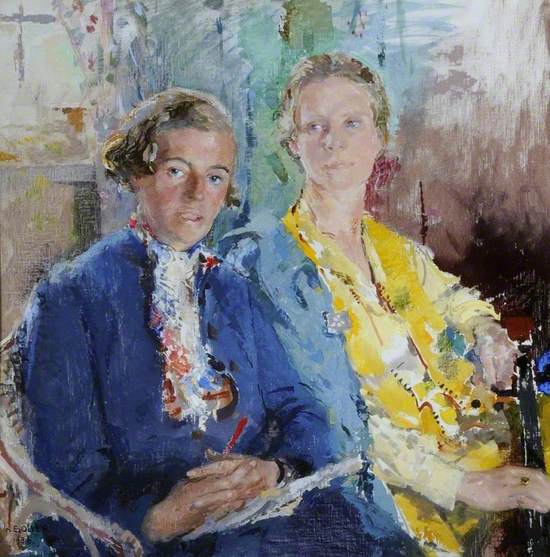You can practice mindfulness by spending time looking at an artwork, and it can be a very helpful tool to calm and settle your thoughts. Longer engagement with a painting or sculpture will produce a deeper sense of appreciation and wellbeing.
Begin by looking at the painting for a couple of minutes. Is there a pattern being formed by the shapes, colours and textures within the painting? Are your eyes drawn to one section of the work that has held your attention?
The Sisters in Wales
'The Sisters in Wales' by Derwent Lee is a primitive symbolic image of two women with short dark hair and long skirts standing in an abstract mountain landscape painted in flat colour blocks.
After a brief stay in Paris, Lees moved to London in 1905 and studied at the Slade School of Fine Art with Henry Tonks and Frederick Brown. He joined its staff in 1908 while still a student, and remained there, on and off, for ten years.
Lees and his wife, Edith Harriet Price (she was one of Augustus John's former models) took a painting trip to Collioure in France. This was shortly after the beginning of the Fauvist movement and he is the only Australian artist known to have had any connection with them.
.
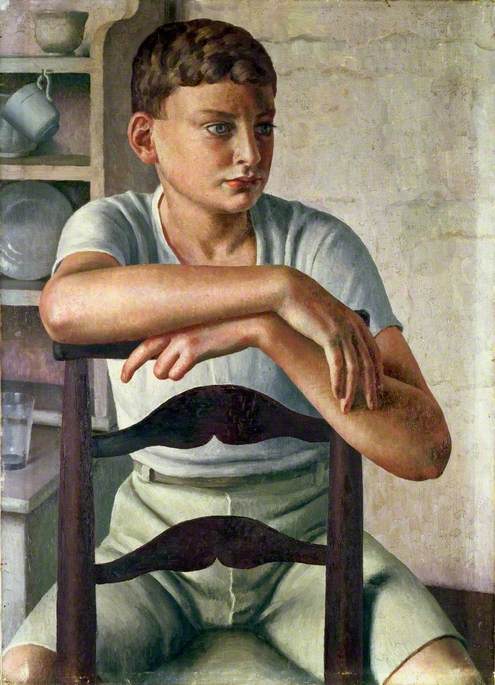
Young Roman
Dod Procter, born Doris Margaret Shaw, was an English artist and was a member of several artists organisations, such as the Newlyn School and became President of St Ives Society of Artists (STISA) in 1966.
Procter, studied at the Atelier Colarossi and was influenced by Impressionism and Post-impressionism and the artists that she met in France, such as Pierre-Auguste Renoir and Paul Cézanne.
She later moved to Newlyn and this was her home for most of her working life. In Newlyn, Procter met Laura Knight, who became a lifelong friend and a considerable influence on her career.
Grey and White
Abstract work entitled 'Grey and White' by Henry Mundy. The work is a drawing in black oil pastel of natural shapes that are undefined and vertical lines on a flat surface overlaid with wash of white paint.
Mundy was a painter and a teacher; he attended the Laird School of Art, 1933–7, then Camberwell School of Arts and Crafts, 1946–50, with Victor Pasmore and William Coldstream. He was married and later divorced the painter Gillian Ayres.
Henry Mundy (1919–2019)
Oil & pastel on paper
H 65 x W 75.5 cm
Ferens Art Gallery
Piazza del Duomo, Taormina, Sicily, Looking up to the Carmine Church
James Kerr-Lawson was only three when his family emigrated from Fife to Hamilton, Ontario. As an adult he later returned to Europe, eventually settling in London, but he maintained links with the artistic community in Canada. He fought in the First World War and in 1917 was commissioned by the Canadian Government to paint the ruined cities of Arras and Ypres.
Kerr-Lawson's paintings of portraits and landscapes of the late 1880s and 1890s show the Realist-plein air influence of Jules Bastien-Lepage, while his decorative paintings from 1904 give evidence of his love of Venetian painting, specifically the work of Canaletto and Tiepolo.
James Kerr-Lawson (1864–1939)
Oil on panel
H 39.5 x W 51 cm
Ferens Art Gallery
Garden at Woodyates Manor, Dorset
Paul Ayshford Methuen had studied drawing at Eton, at the Ruskin in Oxford. In 1927 he attended art classes given by Walter Sickert, which had a permanent effect on his painting style.
In the Second World War he served as a captain until 1944 when he was moved to the Procurement and Fine Art branch set up to protect works of art during the invasion of the continent. He later recounted his experiences in his book Normandy Diary. During the War, Methuen also received a number of commissions from the War Artists' Advisory Committee.
He was elected an Associate of the Royal Academy in 1951, and became a Royal Academician in 1959.
Paul Ayshford Methuen (1886–1974)
Oil on canvas
H 54.5 x W 75 cm
Ferens Art Gallery
The Red Hat (Margaret Meninsky)
In 1918 Bernard Meninsky married Margaret ('Peggy') O'Connor in Marylebone Register Office, and their son David was born later that year. In the first few months of his son’s life, Meninsky created a portfolio of 28 ‘mother and child’ drawings in a variety of media, and the subject became a regular theme throughout Meninsky's career.
'The Red Hat (Portrait of Margaret Meninsky)' was painted when she was pregnant with their second child. She is seated on a wooden chair with the background divided by plain blue and a flowered decorative screen/wall. Wearing red soft brimmed hat over bob cut hair, in pink maternity pinafore dress with white sleeves.
Bernard Meninsky (1891–1950)
Oil on canvas
H 114.2 x W 76.2 cm
Ferens Art Gallery
San Justo, Toledo, Spain
David Bomberg is one of the most significant twentieth-century British artists, although he received little recognition during his lifetime. He is now regarded as a valuable contributor to the history of British modernism.
Bomberg moved to Palestine in the 1920s, his subject matter centring on landscapes and works associated with Yiddish culture.
By the 1940s he turned his attention towards directly influencing a younger generation of artists including Frank Auerbach at the Borough Polytechnic. He gained a reputation as an irascible teacher by his students, Auerbach described him as 'probably the most original, stubborn, radical intelligence that was to be found in art schools.'
David Bomberg (1890–1957)
Oil on canvas
H 50.8 x W 66 cm
Ferens Art Gallery
.
1939–41 (winter landscape - Halsetown)
Ben Nicholson's first notable work was following a meeting with the playwright J. M. Barrie on holiday in Rustington, Sussex, in 1904. As a result of this meeting, Barrie used a drawing by Nicholson as the base for a poster for the play Peter Pan; his father William designed some of the sets and costumes.
In London, Nicholson met the sculptors Barbara Hepworth (to whom he was married from 1938 to 1951) and Henry Moore. On visits to Paris, he met Mondrian, whose work in the neoplastic style (simple shapes and primary colours) was to influence him in an abstract direction, and Picasso, whose cubism would also find its way into his work.
Ben Nicholson (1894–1982)
Oil & pencil on board
H 22.3 x W 28 cm
Ferens Art Gallery
Sunlight and Shadow
Sunlight and Shadow is an oil on canvas of a group of white ducks in a farmyard coup, some shaded by trees while others drink from a water trough in full sunlight.
What draws your eye first to the painting? Look at the shades of colour and the contrast between light and dark. Notice how the light is beaming into the picture and is reflected back to you.
Harry Percy Clifford (1870–1943)
Oil on canvas
H 57.2 x W 76.7 cm
Ferens Art Gallery
Carraroe, County Galway, Ireland
The painting shows an Irish croft with stone walls, hayricks and roof at brow of surrounding hillside fields.
Eileen Bessie Anderson was Art Master at Hymers College in Kingston upon Hull during the 1930s and '40s before moving to the South Coast. A member of Hull Art Club, she had an exhibition at the Ferens Art Gallery in 1948 where her work was upheld for its use of rich colours and imaginative subjects.
Eileen Bessie Anderson (1888–1974)
Oil on canvas
H 40 x W 45 cm
Ferens Art Gallery
Morning Calm, Concarneau, France
Terrick John Williams was educated at Kings College School, London and was expected by his father to continue in the family business. However, his determination to become an artist saw him move to Europe and study under Charles Verlat in Antwerp and later at the Academie Julian. Williams focused on landscape and marine subjects and painted in oil, pastel and watercolour. He travelled extensively and his impressionistic, luminous paintings sought the changing effects of light and reflections.
He was elected a member of the Royal Institute of Painters in Watercolours in 1904.
Terrick John Williams (1860–1936)
Oil on canvas
H 61 x W 81.5 cm
Ferens Art Gallery
A Calm Sea
Almost all of Henry Moore's early pictures were landscapes, painted in many parts of England, or, about 1856, in Switzerland. It was towards 1870, that he began to devote himself almost exclusively to marine subjects. He had a profound and scientific knowledge of wave-form, acquired at the cost of exposure in all weathers, and he was generally content to paint the sea itself without introducing ships or human figures. He made his studies chiefly in the English Channel.
He was elected an Associate of the Royal Academy on 4 June 1885, and a full Royal Academician on 4 May 1893.
The Flowing Tide
Lindner took a very active part in the artistic life of St Ives both as organiser and benefactor. He encouraged and supported young artists, and played key roles in the St Ives Arts Club and St Ives Society of Artists. He had “a ready eye in noticing excellence in all types of work, including the advanced”, and many artists benefited from his foresight and generosity. He offered unfailing support, advice and encouragement, as well as financial assistance, and made the Porthmeor Studios available at reasonable rents. One artist in particular who benefited was Frances Hodgkin, considered one of New Zealand’s most prestigious and influential painters, and Lindner bought several of her paintings and offered her Studio 7 at Porthmeor rent-free.
Moffat Peter Lindner (1852–1949)
Oil on canvas
H 87.5 x W 115.5 cm
Ferens Art Gallery
The Almond Tree
Emily Beatrice Bland painted landscapes and flowers in oil. She studied at London's Slade School of Art under Henry Tonks and Fred Brown and exhibited with the New English Art Club. Throughout the mid-1880s and 1890s the NEAC was dominated by Slade-trained artists. At this time, teaching at the Slade placed an emphasis on studying the effects of light, undermining the importance attached to subject matter. Painted during the 1920s, The Almond Tree reveals the strong influence that French Impressionism had on many British artists well into the twentieth century.
Emily Beatrice Bland (1864–1951)
Oil on board
H 45.5 x W 60 cm
Ferens Art Gallery
Newlyn, Cornwall
The central figure in the Newlyn School of painters, Forbes was committed to working directly from nature in the plein-air (open air) manner of the French. He settled in Newlyn, attracted by "a mild climate suitable for out of doors works".
Forbes painted everyday subjects which offended the tastes of highbrow critics who considered them vulgar. Typical of Forbes' work, the Ferens' painting is a nostalgic view of a way of life that had changed little over the years. It is thought to have been painted in Sandy Cove, Newlyn and uses local people as 'models'. Forbes saw himself recording visual documents of changing scenes and customs.
Stanhope Alexander Forbes (1857–1947)
Oil on canvas
H 123 x W 97 cm
Ferens Art Gallery
Girl in Grey
Louis le Brocquy was a painter, mural and tapestry designer and teacher, born in Dublin and married to the artist Anne Madden.
Le Brocquy is widely acclaimed for his evocative "Portrait Heads" of literary figures and fellow artists, which include William Butler Yeats, James Joyce, and his friends Samuel Beckett, Francis Bacon and Seamus Heaney.
After destroying much of his work in 1963, le Brocquy in 1964 began a series of human heads; his figures are often in isolation, sinister, or seen through the mist of memory.
Girl in Grey is a study of a melancholy dark haired young lady wearing 1940s dress, with bare legs and eastern slippers lying on a dark rug.
Still Life with Roses
'Still Life with Roses' by Mary C Wilson, about 1945. A Modernist still life painted from above of a table cloth on a curved table top which holds a glazed ceramic bowl and white vase with a single white rose and two books, one open and the other closed with a rose lying on top, with muted colours.
Little is known about the artist; if you have any knowledge of Mary C. Wilson please get in touch with the Ferens Art Gallery.
Moonlight, Cornish Coast
Seascape entitled 'Moonlight, Cornish Coast' by Albert Julius Olsson is an Impressionist blue tinted moonlit seascape off the Cornish coast with waves cresting into the shore around two large spurs of rock with a boat on the moonlit water beyond and dark clouds illuminated and broken by silver moonlight.
He exhibited a painting of Newlyn in 1887, and sold a painting at Newlyn in 1897. By then he was an important figure in the St Ives School of artists where, from circa 1890 to 1912, despite having little or no formal artistic training himself, he taught alongside Louis Grier and later Algernon Talmage.
Albert Julius Olsson (1864–1942)
Oil on canvas
H 61 x W 76 cm
Ferens Art Gallery
Cream Head Study
Cream Head Study is one of a group of closely observed and cropped 'body parts', in which she explores heads, arms, hands and sections of the human torso, both male and female. It is a self portrait and shows the vulnerable, haunting and yet lyrical quality she achieves in the faces of her subjects. Its intimate scale contrasts with her other work, much of which is monumental in size.
In 1987 Alison Watt was the winner of the renowned John Player Portrait Award at the National Portrait Gallery, which led to a commission to paint the Queen Mother for the Gallery. She was awarded an OBE in 2008 and became a Fellow of The Royal Society of Edinburgh in 2017.
Alison Watt (b.1965)
Oil on canvas on board
H 18.7 x W 17.7 cm
Ferens Art Gallery
Eileen
Anne Redpath studied at Edinburgh College of Art under Robert Burns and Henry Lintott. Redpath showed her exceptional talent as an artist at a young age and in 1919 she won a travelling scholarship which enabled her to spend that year in Florence, Siena, Bruges and Paris before returning to the Scottish Borders.
Her father was a tweed designer in the Borders. She saw a connection between his use of colour and her own. "I do with a spot of red or yellow in a harmony of grey, what my father did in his tweed."
She and a group of her contemporaries are sometimes called The Edinburgh School. They may be seen as the "heirs" of the Scottish Colourists.
The Idyll
Walter Richard Sickert was probably the single most important artist and art teacher of the Edwardian period. He was one of the founders of the Camden Town Group, and was influential in encouraging a new and very English form of Post-Impressionism. Rather than working en plein air (open air) however, he sometimes based his work upon artists' woodcuts. These were known as the Echoes. Idyll, a late work by Sickert, was painted after an illustration of a wood engraving which appeared in Leisure Hour magazine in 1859. The only significant change the artist has made is a slight reduction in the foreground and sky.
Walter Richard Sickert (1860–1942)
Oil on canvas
H 81.4 x W 85.2 cm
Ferens Art Gallery
Greenhouse and Garden
Stanley Spencer studied at the Slade School of Fine Art in London, under Henry Tonks and others. While at the Slade, Spencer allied with a short-lived group who called themselves the "Neo-Primitives" which was centred on David Bomberg and William Roberts.
In his later years Spencer was seen as a "small man with twinkling eyes and shaggy grey hair, often wearing his pyjamas under his suit if it was cold." Spencer became a "familiar sight, wandering the lanes of Cookham pushing the old pram in which he carried his canvas and easel.
Stanley Spencer (1891–1959)
Oil on canvas
H 76.2 x W 50.8 cm
Ferens Art Gallery
The Big Book
Geoffrey Arthur Tibble was a significant figure in the short-lived Objective Abstraction movement. He later destroyed or overpainted most of the works from this abstract period.
After briefly experimenting with surrealism, by 1937 he had returned to figurative painting, moving toward the Euston Road School of urban realism founded by William Coldstream. In 1944 he became a member of the New English Art Club.
The Big Book depicts a Modernist interior of a woman and girl in a room crowded with furniture.
Geoffrey Arthur Tibble (1909–1952)
Oil on canvas
H 68.8 x W 56.2 cm
Ferens Art Gallery
The Pillion
Hull born Joseph Walter West was a painter, lithographer and designer. He painted figurative and literary subjects and landscapes. He exhibited a number of times at the Royal Academy and the Royal Society of British Artist and was the vice president of the Royal Society of Painters in Watercolours. He produced several posters for the Underground Group.
T.R. Ferens, principal benefactor of the Ferens Art Gallery, was a patron of West's. The Pillion is a romantic history painting. Stylistically, it owes a debt to the Pre-Raphaelites, whose colourful scenes of chivalry and subjects from Arthurian legend were fashionable in the latter part of the 19th century.
Rising Moon
Mary Potter, OBE was an English painter whose best-known work uses a restrained palette of subtle colours and by mixing paint with beeswax, she achieved a "chalky luminous quality".
She studied at the Slade School of Fine Art, under Henry Tonks, where she won many prizes including the first prize for portrait painting.
In his essay for the catalogue of her 1965 Whitechapel Art Gallery exhibition, Mary Potter Paintings 1938–1964, museum director Kenneth Clark said Potter's works "exist in the domain of seeing and feeling; we know that they are exactly right in the same way that we know a singer to be perfectly in tune"; he described her paintings as "enchanting moments of heightened perception".
Musicians
Kate Elizabeth Olver was a painter in oil and watercolour, and was educated at the Royal Academy Schools. She exhibited at the RA, SWA, RP, Royal Glasgow Institute of the Fine Arts and at the Paris Salon.
She illustrated a number of books, including Robert Louis Stevenson’s A Child’s Garden of Verses, with several colour and black and white illustrations.
Kate Elizabeth Olver (1881–1960)
Oil on cardboard
H 75 x W 74.5 cm
Ferens Art Gallery
A Bridge at Bruges, Belgium
Louise Pickard was born in Kingston upon Hull and studied at the Slade School of Art in London between 1898 and 1900 and then studied sculpture in Paris for a time. She exhibited at the Royal Academy on eight occasions between 1909 and her death in 1928. She exhibited at the New English Art Club for the first time in 1909 and became a member in 1923. She also exhibited with the International Society of Sculptors, Painters and Gravers. In January 1924 the Goupil Gallery in London held a joint exhibition by Charles Ginner, Ethel Walker and Pickard.
For many years Pickard had a studio in Chelsea in London and also worked on both the French Riviera and in North Yorkshire for a time.
Louise Pickard (1865–1928)
Oil on canvas
H 54 x W 65 cm
Ferens Art Gallery
Explore artists in this Curation
View all 27-
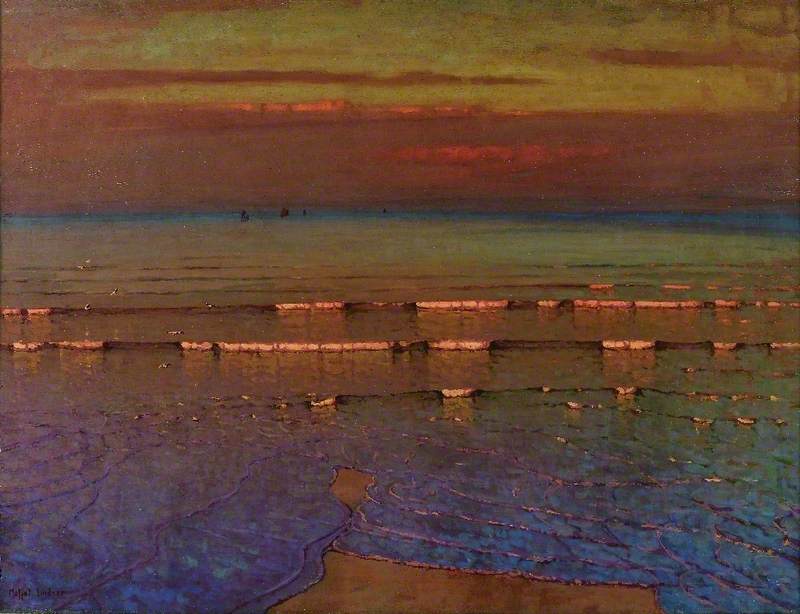 Moffat Peter Lindner (1852–1949)
Moffat Peter Lindner (1852–1949) -
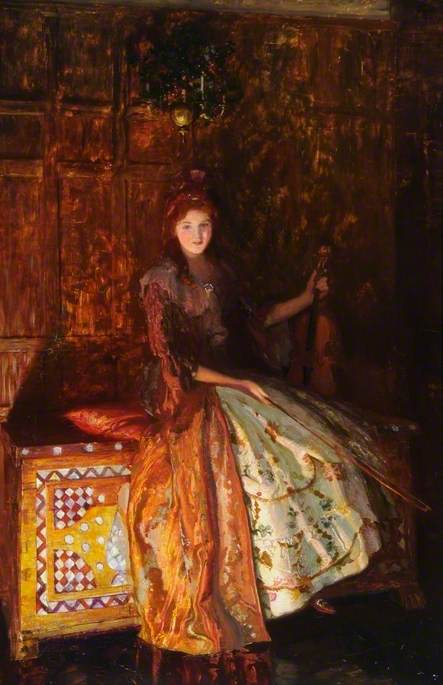 Joseph Walter West (1860–1933)
Joseph Walter West (1860–1933) -
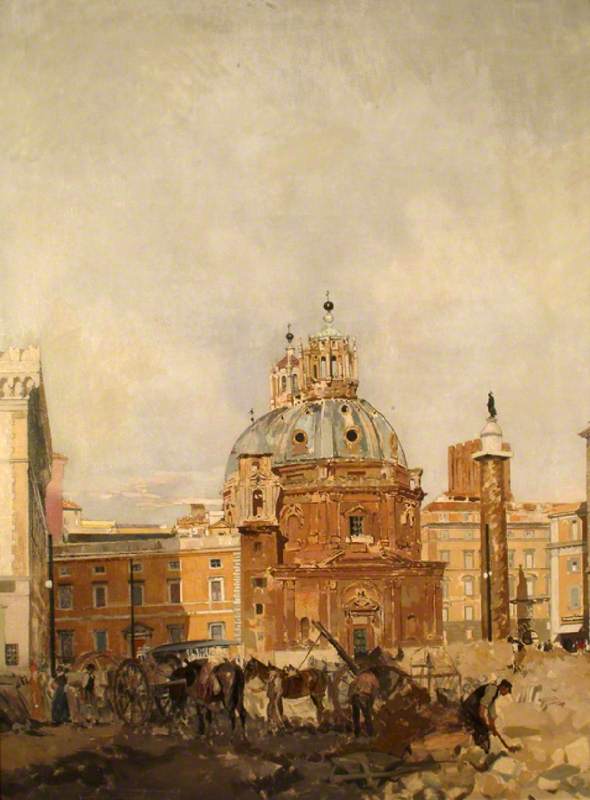 James Kerr-Lawson (1864–1939)
James Kerr-Lawson (1864–1939) -
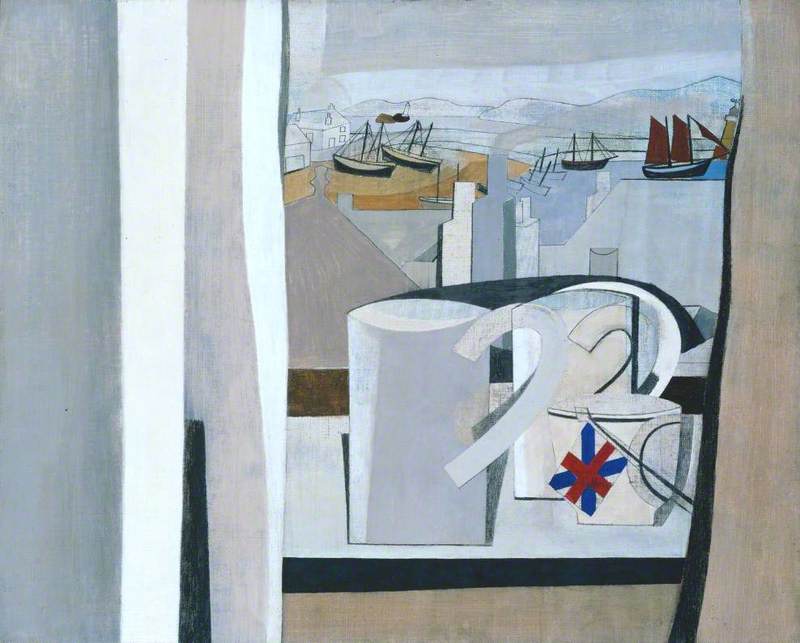 Ben Nicholson (1894–1982)
Ben Nicholson (1894–1982) -
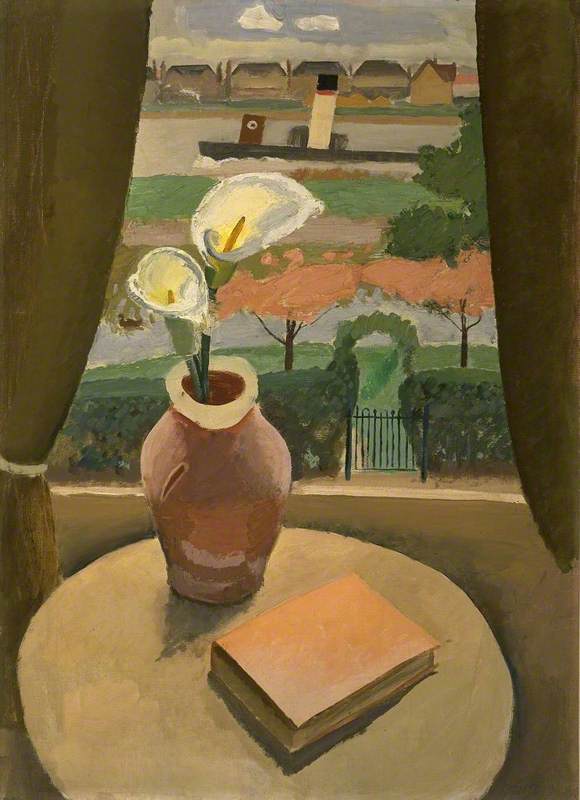 Mary Potter (1900–1981)
Mary Potter (1900–1981) -
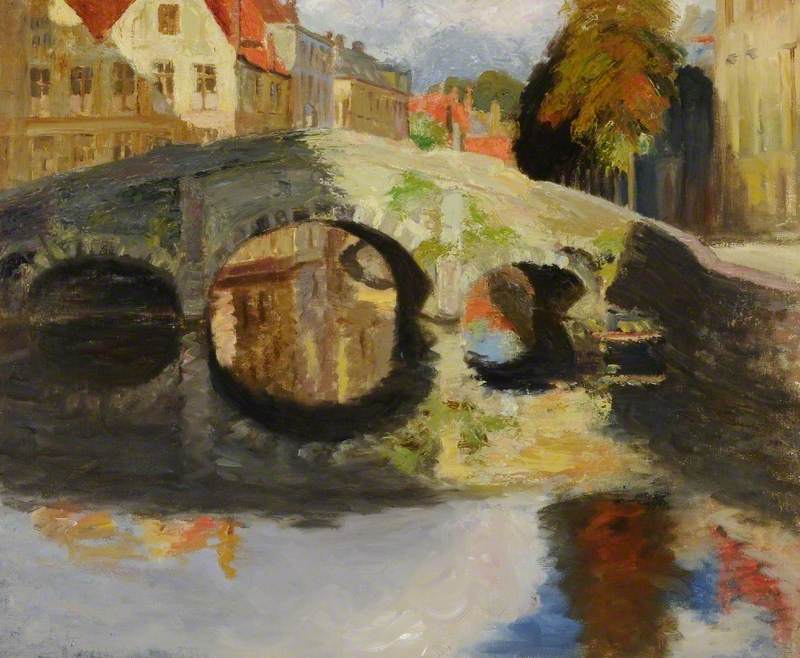 Louise Pickard (1865–1928)
Louise Pickard (1865–1928) -
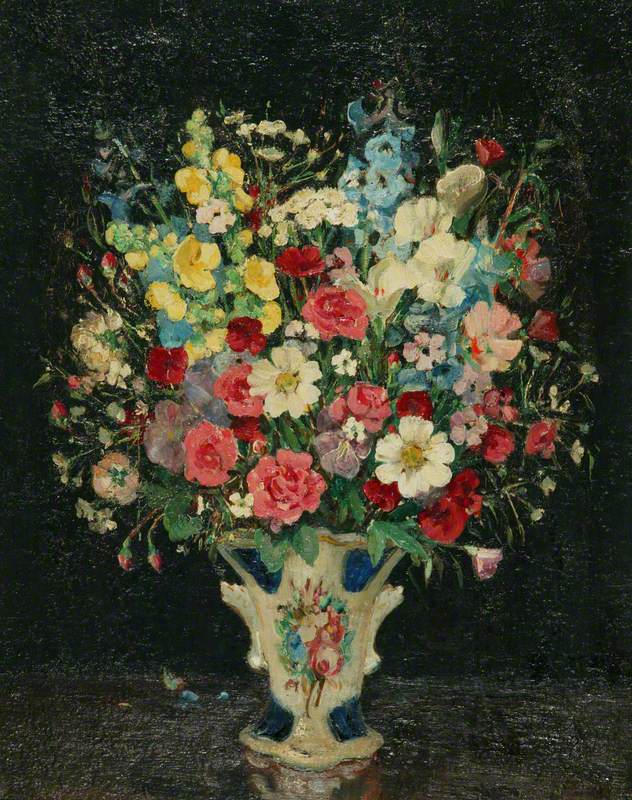 Emily Beatrice Bland (1864–1951)
Emily Beatrice Bland (1864–1951) -
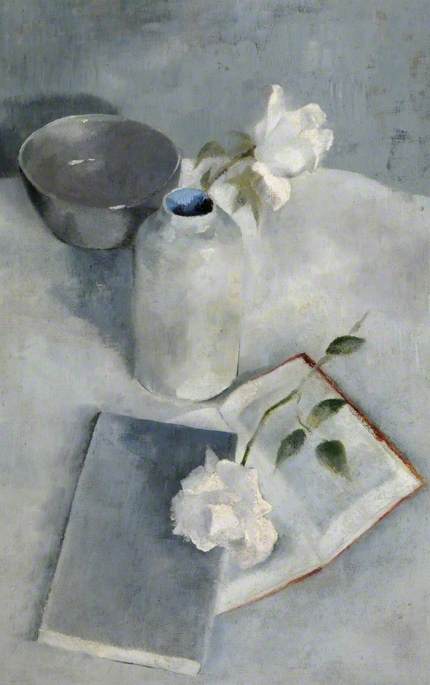 Mary C. Wilson
Mary C. Wilson -
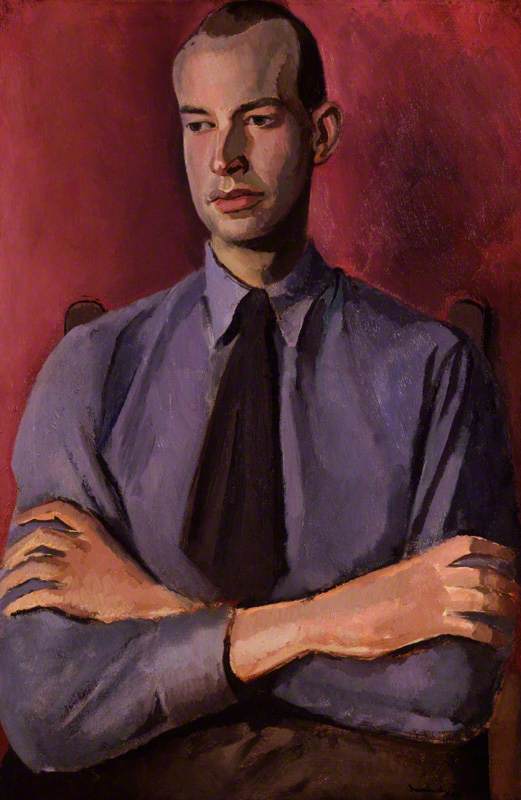 Bernard Meninsky (1891–1950)
Bernard Meninsky (1891–1950) -
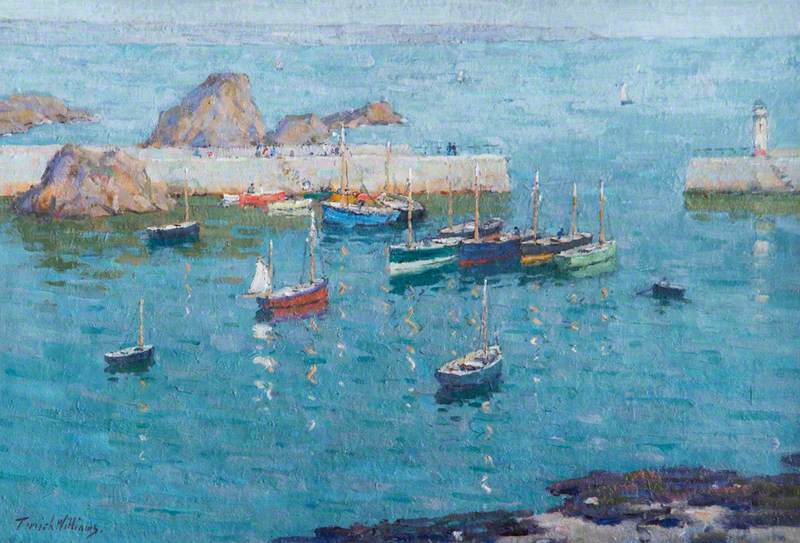 Terrick John Williams (1860–1936)
Terrick John Williams (1860–1936) - View all 27
